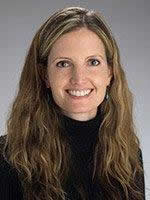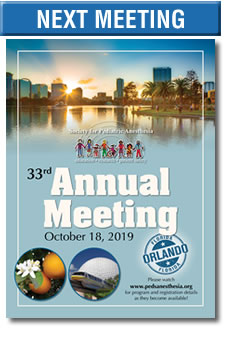SPA Meeting Reviews
Saturday Session I: Deep in the “Heart” of Texas - A Special Expert Session
The Pediatric Heart and Lungs: A match made in heaven…until it’s not!
Reviewed by: Heather Mitzel Levy, DO
University of Kansas Medical Center
 |
Dr. Mitzel Levy |
Following Friday’s outstanding lectures, Emad Mossad, MD (Texas Children’s Hospital) got our Saturday morning off to a fantastic start! Dr. Mossad spoke about a topic which we all are able to see in action everyday in the operating room - the interplay between the pediatric heart and lungs. He first set out to examine the affects of both spontaneous and controlled ventilation on the cardiac system and then discussed the application of those principles to patients with congenital heart disease.
Dr. Mossad equated the relationship between the heart and lungs as being like a tango - two organs with one purpose, delivering oxygen to the body. His first slides discuss the different sequelae that occur within the thorax during mechanical versus spontaneous breathing.
With spontaneous breathing, there is negative intrathoracic pressure and increased intra-abdominal pressure. The combination of the increased pressure on the extrathoracic great veins and decreased right atrial pressure lead to an increase in venous return to the heart. He showed several graphs which demonstrated that even slight increases in right atrial pressure, can significantly influence both venous return and RV preload, as venous return is dependent on the gradient between the RAP and CVP. The numbers he quoted were 1 mmHg increase in RAP leads to 15% decrease in RV preload. The left ventricles preload demonstrated the product or downstream gradient between the PA and the PV/LA junction. Right ventricular filling should approximate LV preload assuming a patient has a normal PVR, however he noted that as RV filling increases, there can be significant decreases in LV filling due to ventricular interdependence. The formula used to calculate a transmural LV pressure (or LV afterload) is LV chamber pressure minus the extracavity pressure or intrathoracic pressure. Therefore if the LV chamber pressure is 120, and the intrathoracic pressure is -20 (as is seen in spontaneous ventilation), the transmural LV pressure would be 120 - (-20) to equal 140. So the transmural pressure really reflects the true filling pressure of the ventricle during diastole.
With mechanical ventilation, or positive pressure ventilation, we see an increase in intrathoracic pressure, which leads to increased right atrial pressure and a decrease in venous return, or preload. There is an increase in the PVR or afterload of the RV due to the compression of the alveolar vessels by the lung inflation. Due to thoracic pump augmentation, there should be an increase in pulmonary venous return to the left atrium and left ventricle. However, this effect is counteracted by the over-distended alveoli which lead to increased PVR and therefore overall there is decreased LV preload. The LV afterload is decreased- again using the same formula from above: LV afterload 100 =LV chamber pressure (120) – Intrathoracic pressure (+20).
After concluding his excellent review on the interdependence of the pulmonary and cardiac systems, Dr. Mossad finished his lecture by tying in the previous principles to children with congenital heart disease. He spoke about the advantages of early extubation, referring to a study from pediatric critical care in 2016 which showed in children with coarctation or TOF, early extubation leads to less IV sedation, earlier feeding, shorter ICU stay, lower complication rates, and lower hospital costs. Furthermore, he spoke about early extubation in the Post-Fontan children, targeting an extubation rate in the OR of >85% of the time at his institution. Additionally he stated that these children benefit greatly from a vasopressin infusion to increase venous tone and improve outcomes. Finally, Dr. Mossad concluded by talking about the benefits of spontaneous ventilation with CPAP in children with heart failure and acute pulmonary edema.
Building Hearts in the Lab: Science or science fiction?
The second lecture of the morning continued on the cardiac trajectory and was delivered by Luiz Sampaio, MD, MS (Texas Heart Institute). Dr. Sampaio delved into the world of laboratory medicine in his lecture appropriately titled "Building Hearts in the Lab: Science or science fiction?"
Among his first slides, Dr. Sampaio informed us that every year we are performing more and more transplants, using both living and deceased donor organs. Due to such a massive need, he talked about the potential of building our own organs and how that would solve the problem of not having enough organs of the right size, as well as to decrease the need for immunosuppression. He summarized the two current options for building an artificial heart, namely building one as a device, or using what already exists, meaning biological tissue.
Dr. Sampaio further educated us about research within the field of regenerative medicine by speaking of his experiment which involved placing a decellurized heart into the thoracic cavity of a large animal. Interestingly, his team found that after leaving the heart within the animal for 24 hours, it had been repopulated with cells and that the cells had migrated in and localized in the correct locations. After 30 days in the animal with perfusion from the host, the organ was repopulated with muscle fibers. He stated that getting enough cardiomyocyte cells is the major rate-limiting step in cardiac regenerative medicine. In order to get past that hurdle, his team starting using stem cells from blood or skin cells to grow cardiomyocytes in a closed cell expansion system. After injecting the cells within the heart, they noted that after 30 days there was some spontaneous beating of the heart.
To conclude his talk, Dr. Sampaio discussed possible solutions for single ventricle CHD, including a sub-pulmonary assist device such as a tissue-engineered pump. The characteristics of this pouch would need to be exquisitely particular, including being non-thrombogenic, infection resistant, bio compatible, and have the capacity to last long term. The next five years will prove to be busy in Dr. Sampaio’s lab, as demonstrated when he outlined his ambitious goals and timeline on one of his final slides.






